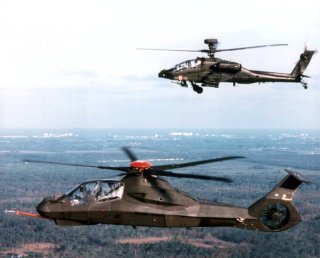Why America’s RAH-66 Comanche Stealth Helicopter Crashed and Burned
The quest for a true stealth helicopter continues.
After decades of development and nearly $7 billion spent on the Comanche program, it came to a close with just two operational prototypes ever reaching the sky.
The Comanche’s life after death
While originally slated for a production run of 1,213 RAH-66 Comanche helicopters, the U.S. Army only ever took possession of the original two prototypes… but that doesn’t mean the program was a complete loss. In fact, among Defense Department insiders, the RAH-66 Comanche program is still seen in a fairly positive light. The difference in perception of the Comanche’s success or lack thereof could potentially be attributed to elements of other classified programs the American public isn’t privy to.
In 2011, Deputy Undersecretary of the Army Thomas Hawley was asked a question by a journalist about the “failed Comanche program.”
“I wouldn’t say Comanche was necessarily a failure of procurement… Comanche was a good program.”
-Deputy Undersecretary of the Army Thomas Hawley
A similar sentiment was also registered by (now former) Army Chief of Staff General Peter Schoomaker:
“Much of what we’ve gained out of Comanche we can push forward into the tech base for future joint rotor-craft kinds of capabilities.”
-Army Chief of Staff General Peter Schoomaker
These assertions make some sense, but are also easily dismissed thanks to the noticeable lack of stealth rotorcraft in America’s arsenal. How could lessons from the Comanche really be used if the premise itself doesn’t carry over into further programs?
One high-profile possibility came in the form of images that emerged following the raid on Osama Bid Laden’s compound that resulted in the death of the terrorist leader… As well as the loss of one highly specialized Blackhawk helicopter. Immediately following the announcement of Bin Laden’s death, images began to surface online of a very unusual tail section that remained intact after American special operators destroyed the downed helicopter to ensure its technology couldn’t fall into enemy hands.
The tail is clearly not the same as the tail sections of most Blackhawk helicopters, and its angular design certainly suggests that it must have come from a helicopter that was intended to limit its radar return. Eventually, stories about America’s Special Operations Stealth Blackhawks, or Stealth Hawks, started making the rounds on the internet, and recently, the team over at The Warzone even managed to dig up a shot of just such a stealthy Blackhawk–likely a predecessor to the helicopters used in the historic raid.
While these modified stealth helicopters are not Comanches, the modifications these Blackhawks saw were almost certainly informed by lessons learned in the RAH-66 program. Reports from the scene of the raid also indicate how quiet the helicopters were as the American special operations team closed with their target. Clearly, efforts made to reduce the helicopters’ radar cross section, infrared signature, and noise level were all in play during the Bin Laden raid, just as they were within the Comanche prototypes.
And then there’s Sikorsky’s latest light tactical helicopter, the S-97 Raider. Its visual cues are certainly reminiscent of the company’s efforts in developing the RAH-66, and its performance is too. The S-97 Raider has been clocked at speeds in excess of 250 miles per hour–faster even than the proposed Comanche’s top speed–and like the Comanche, the Raider is nimble to boot.
The RAH-66 Comanche stealth helicopter may have been a bit too forward reaching for its time, but the lessons learned throughout its development and testing have clearly found new life in other advanced programs. With defense officials increasingly touting the value of stealth to increase combat aircraft survivability, it seems certain that we’ll see another stealth helicopter enter service at some point; And when we do, it will almost certainly have benefitted from the failures and successes of the Comanche.
This article first appeared at Sandboxx.
Image: Flickr.

